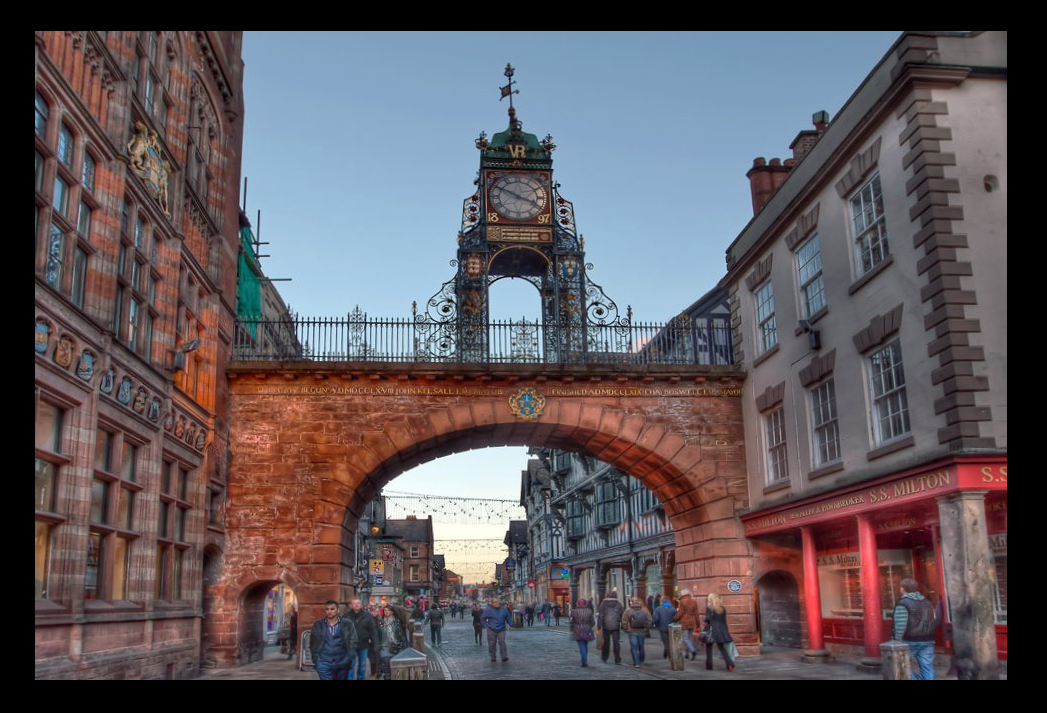Difference between revisions of "Chester's Eastgate and the Eastgate Clock"
(Created page with "; '''Chester''' [[]] <br> <br> '''Description:''' Eastgate and Eastgate Clock in Chester, UK, stands on the site of the original entrance to the Roman fortress of Deva Vic...") |
|||
| Line 1: | Line 1: | ||
; '''[[Chester]]''' | ; '''[[Chester]]''' | ||
| − | [[]] | + | [[File:Chester Eastgate & Clock tower.png]] |
<br> | <br> | ||
<br> | <br> | ||
'''Description:''' Eastgate and Eastgate Clock in Chester, UK, stands on the site of the original entrance to the Roman fortress of Deva Victrix. It is a prominent landmark in the city of Chester and is said to be the most photographed clock in England after Big Ben. The original gate was guarded by a timber tower which was replaced by a stone tower in the 2nd century, and this in turn was replaced probably in the 14th century. The present gateway dates from 1768 and is a three-arched sandstone structure which carries the walkway forming part of Chester city walls. In 1899 a clock was added to the top of the gateway to celebrate the diamond jubilee of Queen Victoria two years earlier. It is carried on openwork iron pylons, has a clock face on all four sides, and a copper ogee cupola. The clock was designed by the Chester architect John Douglas. The whole structure, gateway and clock, was listed by English Heritage on 28 July 1955 as a Grade I listed building. | '''Description:''' Eastgate and Eastgate Clock in Chester, UK, stands on the site of the original entrance to the Roman fortress of Deva Victrix. It is a prominent landmark in the city of Chester and is said to be the most photographed clock in England after Big Ben. The original gate was guarded by a timber tower which was replaced by a stone tower in the 2nd century, and this in turn was replaced probably in the 14th century. The present gateway dates from 1768 and is a three-arched sandstone structure which carries the walkway forming part of Chester city walls. In 1899 a clock was added to the top of the gateway to celebrate the diamond jubilee of Queen Victoria two years earlier. It is carried on openwork iron pylons, has a clock face on all four sides, and a copper ogee cupola. The clock was designed by the Chester architect John Douglas. The whole structure, gateway and clock, was listed by English Heritage on 28 July 1955 as a Grade I listed building. | ||
Latest revision as of 17:33, 18 February 2014

Description: Eastgate and Eastgate Clock in Chester, UK, stands on the site of the original entrance to the Roman fortress of Deva Victrix. It is a prominent landmark in the city of Chester and is said to be the most photographed clock in England after Big Ben. The original gate was guarded by a timber tower which was replaced by a stone tower in the 2nd century, and this in turn was replaced probably in the 14th century. The present gateway dates from 1768 and is a three-arched sandstone structure which carries the walkway forming part of Chester city walls. In 1899 a clock was added to the top of the gateway to celebrate the diamond jubilee of Queen Victoria two years earlier. It is carried on openwork iron pylons, has a clock face on all four sides, and a copper ogee cupola. The clock was designed by the Chester architect John Douglas. The whole structure, gateway and clock, was listed by English Heritage on 28 July 1955 as a Grade I listed building.